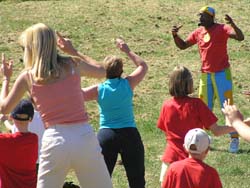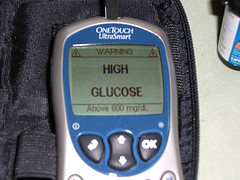Physical fitness
Contents
- 1 Physical Fitness
- 2 What types of exercise are there?
- 3 Benefits of Physical Fitness
- 4 Lifestyle Habits
- 5 Lifestyle Diseases
- 6 Osteoporosis
- 7 Cardiovascular Disease
- 8 Obesity
- 9 Non-insulin Dependent Diabetes also referred to as adult-onset diabetes-also referred to as adult-onset diabetes
- 10 Holistic Health
Physical Fitness
<kaltura-widget kalturaid='292681' size='M' align='R'/>
Physical fitness is a state of well being that allows a person to perform daily activities with vigour, reduces the risk of health problems relating to lack of exercise, and is a sufficient fitness base to provide energy for daily participation in recreational physical activities and for handling emergencies
What types of exercise are there?
Aerobic Exercise
Aerobic exercise increases your heart rate, works your muscles, and raises your breathing rate. For most people, it is best to aim for a total of about 30 minutes a day, at least 5 days a week. If you haven't been very active recently, you can start out with 5 or 10 minutes a day and work up to more time each week. Or split up your activity for the day - try a brisk 10-minute walk after each meal. If you are trying to lose weight, you may want to exercise more than 30 minutes a day. Here are some examples of aerobic exercise:
- A brisk walk (outside or inside on a treadmill)
- Dancing
- A low-impact aerobics class
- Swimming or water aerobic exercises
- Ice-skating or roller-skating
- Tennis
- Riding a stationary bicycle indoors
Strength Training
Strength training, done several times a week, helps build strong bones and muscles and makes everyday chores like carrying groceries easier for you. With more muscle, you burn more calories, even at rest. Here are some ways to do it:
- Join a class to do strength training with weights, elastic bands, or plastic tubes
- Lift light weights at home
Flexibility Exercises
Flexibility exercises, also called stretching, help keep your joints flexible and reduce your chances of injury during other activities. Gentle stretching for 5 to 10 minutes helps your body warm up and get ready for aerobic activities such as walking or swimming. Your health care team can provide information on how to stretch.
Being Active Throughout the Day
In addition to formal exercise, there are many opportunities to be active throughout the day. Being active helps burns calories. The more you move around, the more energy you will have. These strategies can help you increase your activity level:
- Walk instead of drive whenever possible
- Take the stairs instead of the elevator
- Work in the garden, rake leaves, or do some housecleaning every day
- Park at the far end of the shopping centre lot and walk to the store
Benefits of Physical Fitness
Longevity and Aging
Exercise, even after age 50, can add healthy and active years to one's life. Studies continue to show that it is never too late to start exercising and that even small improvements in physical fitness can significantly lower the risk of death. Simply walking regularly can prolong life in the elderly.
Moderately fit people, even if they smoke or have high blood pressure, have a lower mortality rate than the least fit. Resistance training is important for the elderly; because it is the only form of exercise that can slow and even reverse the decline in muscle mass, bone density, and strength. Adding workouts that focus on speed and agility may be even more protective for older people. Flexibility exercises help reduce the stiffness and loss of balance that accompanies aging.
Diabetes
Diabetes, particularly type 2, is reaching epidemic proportions throughout the world as more and more cultures adopt Western dietary habits. Aerobic exercise is proving to have significant and particular benefits for people with both Type 1 and Type 2 diabetes; it increases sensitivity to insulin, lowers blood pressure, improves cholesterol levels, and decreases body fat. Regular exercise, even of moderate intensity, improves insulin sensitivity. In fact, studies of older people who engage in regular, moderate, aerobic exercise (e.g., brisk walking, biking) lower their risk for diabetes even if they do not lose weight. Anyone on insulin or who has complications from diabetes must take special precautions before embarking on a workout program.
Effects on Colds and Flu
Although offering no evidence of improved immunity from exercise, one study reported that people who exercised as little as once a week in employee fitness programs averaged nearly five fewer sick days annually than those who did not participate in such programs. The immediate effect of exercise on the immune system is uncertain. High-intensity or endurance exercises might actually suppress the immune system while they are performed. For instance, some highly trained athletes report being susceptible to colds after strenuous events. A recent study suggested that in people who already have colds, exercise has no effect on the illness -- severity or duration of the infection. People should avoid strenuous physical activity when they have high fevers or widespread viral illnesses, however.
Pregnancy
Healthy women with normal pregnancies should exercise at least three times a week, being careful to warm up, cool down, and drink plenty of liquids. Many prenatal callisthenics programs are available. Experts advise, in general, that when exercising, the expectant mother's pulse rate should not exceed 70% to 75% of the maximum heart rate or more than 150 beats per minute. Fit women who have exercised regularly before pregnancy, however, may work out more intensively as long as no discomfort occurs. According to a new study, vigorous exercise may improve the chances for a timely delivery. Overly strenuous exercise during pregnancy is not advocated, however, for women who did not exercise intensely before becoming pregnant. And all pregnant women should avoid high-impact, jerky, and jarring exercises, such as aerobic dancing, which can weaken the pelvic floor muscles that support the uterus. During exercise, women should monitor their temperature to avoid overheating -- a side effect that can damage the foetus. (Note: No pregnant women should use hot tubs or steam baths, which can cause foetal damage and miscarriage.) Swimming may be the best option for most pregnant women. It involves no impact, overheating is unlikely, and swimming face down promotes optimum blood flow to the uterus. Walking is also highly beneficial. To strengthen pelvic muscles, women should perform Kegel exercises at least 6 times a day, which involve contracting the muscles around the vagina and urethra for 3 seconds 12 to 15 times in a row
Lifestyle Habits
Lifestyle Diseases
Regular exercise can bring you benefits ranging from cardiovascular fitness to enhancing your stress coping skills. It also reduces the risk of chronic conditions including:
- osteoporosis
- cardiovascular disease
- obesity
- non-insulin dependent diabetes
Osteoporosis
This is a disease of bone in which involves the reduction of bone matter such as calcium and a variation in certain bone proteins. The result is a reduction in bone mass making it more susceptible to fractures. Menopausal and post menopausal women are particularly at risk.<p> <p>You can reduce the risk of developing osteoporosis by engaging in thirty minutes of weight-bearing exercises such as walking or jogging, three times a week. This increases bone density and flexibility while at the same time strengthening - the muscles in the legs and back, thus reducing the risk of falls.
Cardiovascular Disease
Regular exercise acts as a preventive measure against heart disease. Recent studies have shown that aerobic exercises such as swimming, brisk walking, or tennis can result in a reduced incidence of cardiovascular disease. Dr Ralph Paffenbarger has shown in a study on over 10,000 Harvard male graduates conducted over a twenty year period that alumni who adopted a sedentary lifestyle had a 25% higher risk of dying from all causes and a 36% higher risk of dying from coronary heart disease.
High Cholesterol
High blood cholesterol is considered a major risk factor for coronary heart disease. High levels of low density lipoproteins (LDL)cholesterol increase the risk of coronary artery disease while high levels of High density lipoproteins (HDL) cholesterol reduces the risk. Intense exercise have been shown to increase the HDL cholesterol and decrease the LDLs. Research has show that even moderate exercise as brisk walking has increased the HDL and decreased the LDL.
Hypertension
Hypertension, commonly referred to as "high blood pressure", is a medical condition in which the blood pressure is chronically elevated. Hypertension has been associated with a higher risk of heart attack or stroke. Regular exercise is considered as one of the first steps in controlling blood pressure
Obesity
You may recall that obesity and its causes were discussed in this section. http://wikieducator.org/index.php?title=Life_Style_Diseases&action=edit§ion=3 As you may recall obesity occurs when food input exceeds muscular output over a long period of time. Inactivity is one of the major causes of obesity. Exercise increase the basal metabolic rate (BMR). In other words, it increases the rate at which your body burns calories. Exercise also increases the size of muscles and the number of muscle cells. Person who diet to lose weight without exercising , do so at the expense of body protein. Aerobic exercise protects against the loss of protein tissue and enhances the breakdown of fats to supply energy. The more muscle tissue you have the higher your BMR is going to be. In addition, by increasing the amounts of high density cholesterol and reducing the low density cholesterol in the blood, it is believed that exercise changes the way your body metabolizes fats. Low levels of high density cholesterol are associated with obesity.
Non-insulin Dependent Diabetes also referred to as adult-onset diabetes-also referred to as adult-onset diabetes
this is yet another chronic disease which tends to be more common in people with sedentary lifestyles. Studies have shown that even moderate amounts of exercise such as dancing, walking bicycling reducing the risk of this type of diabetes. Regular exercise increases the sensitivity of cells to insulin and reduces abdominal fats. These are significant risk factors for non-insulin dependent diabetes.








